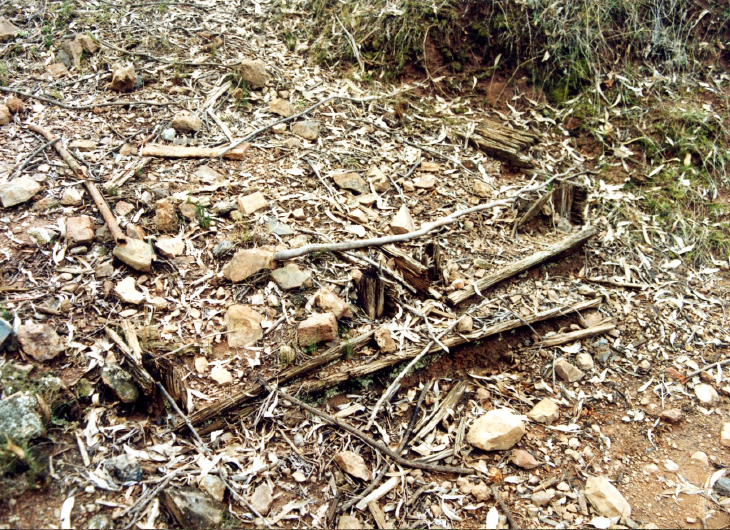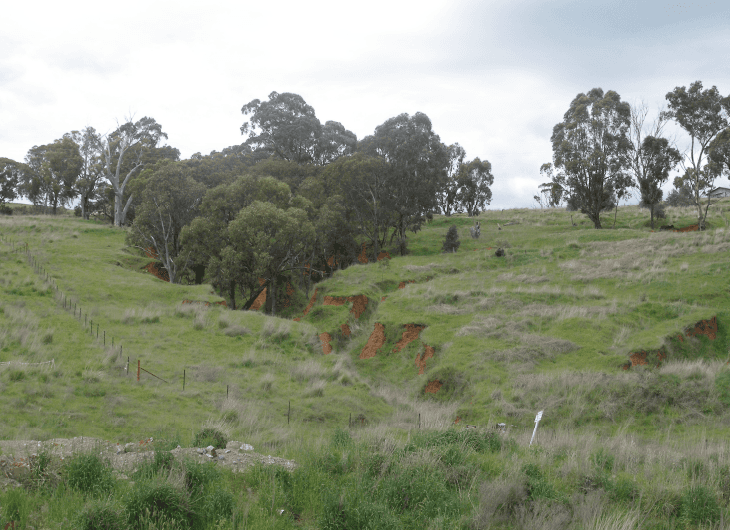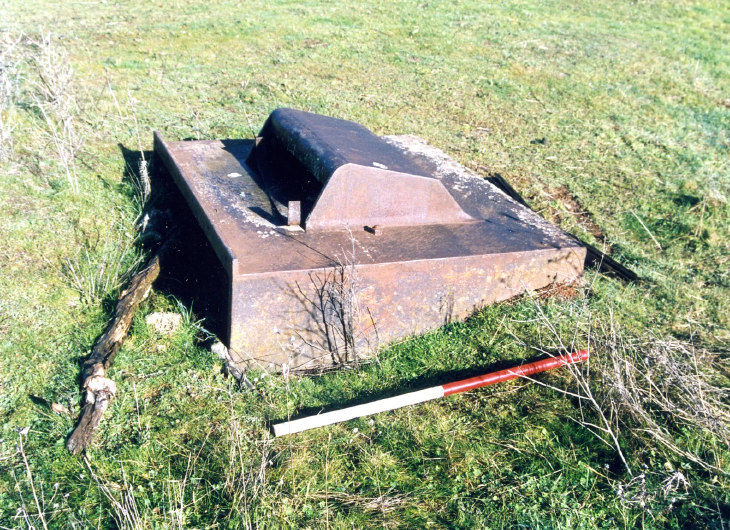Historical Timeline
Hopes raised and dashed
1870's - 1890's
Hopes raised and dashed, 1870's - 1890's
During the period from the 1870s to the turn of the century, the local population was largely sustained on the small-scale gold mining and brief periods of copper mining, but it was not on a scale that sustained a population similar to the 1860s.
Between 9 May 1870 and 20 September 1871, Josiah Holman leased the Cadia mines from the Scottish Australian Mining Company. A report in the Australian Town and Country Journal described Holman’s attempts to reopen the mine and to continue the smelting of ores.
During this lease, Josiah Holman also worked a shaft at Holman’s Reef, located at the south end of Cadia Village. Others were involved in digging at the Western Reefs, which were thought to be outside the Cadia Properties until the survey for the new fence in 1880.
After this attempt to keep the mine working, Josiah Holman left for the Company’s copper mine at Rockhampton, Queensland. While there was no copper mining activity at Cadia between September 1871 until his return in 1876, others had successfully opened up Trathen’s Auriferous Vein at East Cadia, where a gold nugget of 39 ounces was found. These workings date from 1873 to 1877, but were attended without further success.
Under directions from the Scottish Australian Mining Company to work the mines at Cadia, but only on the basis “to make the return equal to expenditure”, Holman again used the White Engine from August 1876 to September 1878, producing 1,020 tons of ores with nearly 11% copper content. The balancing of the books was not achieved, because of the poor prices for copper on the international market. The results of goldmining likewise displeased the directors.
From 1880 onwards Josiah Holman again became a yearly tenant of the mine, maintaining all the plant in good order. The old copper ore crushing plant (presumably at the Engine House) was partly converted to testing for gold in November 1882.
In 1883 the equipment for obtaining gold was extended with an overshot waterwheel to be used in place of steam power, if sufficient water was available. The principal areas for gold sluicing were located above the East Cadia workings (Trathen’s Reef) and at West Cadia, between the North and South Sections, in both of which areas substantial remains of sluicing still survive.
In spite of the low production rates, Holman rebuilt a copper furnace in 1884, with the intention of smelting the ores at hand (Furnace 6 at Copper Smelter No. 1).
Gold sluicing and mining continued on a small scale around Trathen’s Reef from 1884-1886, where a 30 ounce nugget was found in 1884.
By 1887 the Company had come to the view that the Great Iron Lode (Iron Duke) was the likely location of the source of the alluvial gold. Captain Holman now concentrated his miners on this area, recovering small quantities of gold. Although the aim had been to find the mother lode of gold, instead the company found new reserves of copper. Ores were smelted in 1888 and Captain Holman put Copper Smelter No. 1 to final use in late 1891. These furnaces had served the company well since 1861-1862.
By early 1893 Josiah Holman was simply occupying the house and farm at Cadia, paying a minimal rent and receiving no remuneration from the Company. Holman died on 18 September 1893.
Mr. T. Croudace is first mentioned as the new mine manager in the company report of December 1892.
Between 1891 and 1897, there was no activity of consequence at Cadia. In 1897 the Scottish Australian Mining Company tried to reopen the copper resources previously exploited by Holman in 1887-1891, but the work was brought to a halt by legal action over a disputed mining claim. Although the case “Zobel vs. Croudace” was resolved in the company’s favour in June 1899, the local community resented the role of the Scottish Australian Mining Company in prohibiting other members of the community from earning a living by mining.
Evidence for gold mining at Cadia from 1870 to 1900
The physical evidence for gold mining at Cadia from 1870 to 1900 includes mine shafts, two water races, remains of two stamper batteries as well as sluicing. One water race served the west side of Cadiangullong Creek, ending at a stamper battery. The other served the workings on Trathen’s Reef, commencing on Rodds Creek. The water races and workings are clearly shown on the 1881 plan of the Cadia Properties.
The site of the stamper battery in Cadia Village may be the one that was powered by a waterwheel in 1883.
Evidence for sluicing for gold is found at East Cadia and between the old North and South Section Mines.
The text of the Australian Town and Country Journal, 7 May 1870, page 14-15 (with spelling as in original – for example, Cadiangollong (sic)):
CADIA – COPPER.
The Cadiangollong Copper Mine is fourteen miles from Orange, a severe twelve from Cargo, and fifteen from Carcoar.
This dis- (and ex-) tinguished company was composed originally of Messrs. Icely, Want, Samuels, Lawson and others, who bought the ground (1600 acres)of the Crown, and based that portion of it east of the creek to Messrs. Morehead and Young, of Sydney, who raised 3000 tons, erected four furnaces, and smelted a quantity of ore. Subsequently in May 1864, the Cadiangollong Copper Mining and Smelting Company was formed in 60,000 shares at £1; merely 40,000 being paid up, and 20,000 contributing – which company raised 5000 tons of ore, making in all 8000 tons, reduced to 850 tons fine copper. A trifling inconvenience appears to have arisen about the end of 1867; the capital was all called up, and the work ceased.
Of the amount of work done, an idea may be formed from the following figures: – The lodes, four in number, vary from one to six feet thick – (the north is metamorphic slate, the south is syenitic granite; lodes running east and west) – average per centage of copper twelve, but at the last improving. The shafts are thirteen in number, three of which are forty fathoms each, and ten vary from ten to twenty-five fathoms each. The engine shaft is twelve feet by five feet, and another nine feet by four feet, two chambers each; smallest shafts six feet by four feet, and slabbed. 4500 feet, or nearly a mile of driving has been done at various levels; and the working drawings show a large amount of stoping done, as well as a deal of “solid” remaining in the lodes.
Measures are now being taken for re-opening this mine, and starting afresh; but at present the furnaces are at work upon a rich red sample from Woods’s Flat, thirty-two mines away in the south-west; eighty-five tons brought in go as high as forty per cent. pure copper, and couldn’t be reduced until some bags of pyrites were borrowed from the Canobolas Copper Mine (a poor neighbour to the Cadia, averaging three per cent. copper, and distant one mile and a half, south-east) to flux it. These furnaces go through the processes complete – viz., first, smelting regulus; second, coarse copper (in this case, but not always); third, refined copper. That scarse article, a good Welsh smelter, is to be found here.
At the shaft, and erected in a solid stone house, built by Cornishmen, is the engine, of forty-horse power and ten-feet stroke. It is a low-pressure condenser with a thirty-feet beam, and fly and driving wheels twenty-seven feet in diameter, constructed to wind by a flat chain; boiler, thirty feet long, seven feet six inches diameter, weighing ten tons. Beside it is a portable engine of twelve-horse power, with forty fathoms of six-inch pumping gear, all fixed as well as winding gear; and another portable engine, of eight-horse power, on a roving commission. There are three furnaces in use, and three require rebuilding or repairs.
The first process in treating the stone is done by boys, who handpick it, separating the ore from barren rock, the ore being removed at once to the furnace, the intermediate or coarse ore only going through the processes of crushing and jigging.
Appleton’s stone-breaker driven by a belt, begins by cracking the stone neatly to the size of road metal, whence it meets with heavy Cornish cast-iron rollers, which again reduce and discharge it to a wheel fourteen feet in diameter and ten on the rim, having internal buckets which carry up again the stone, which is still too large to pass through the meshes of a circular revolving sieve. Eight jigging machines jumping under water in as many slabbed pits separate by specific gravity the ore sand from the silica coming from the sieve, and boys skim the latter off periodically.
Beside the extensive plant already enumerated, commodious workshops contain any amount of spare machinery: lathe, saw-bench, circular saws, pinions, spurs, bar iron and round iron, tools, and implements – the very anatomy of mechanism, and sufficient to make the gum-trees weep after a night’s fog, to see them lie idle and rusty. To Captain Holman I have much pleasure in being indebted for most of the above information, and looking round his office I perceive an assay furnace, plumbago pots, crucibles, and all the apparatus for assay. The office is roomy, and built of stone and copper slag. A fine clay is found here for brick-making.
Burnt Yards and the Forest. – These very interesting fields are too large to come within the compass of this letter. They will have to wait for the settlement of their account.
New Royal Hotel, Orange, 28th April, 1870.




